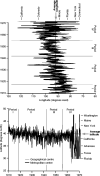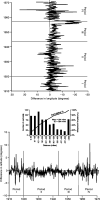The Spatial Dynamics of Poliomyelitis in the United States: From Epidemic Emergence to Vaccine-Induced Retreat, 1910-1971
- PMID: 16741562
- PMCID: PMC1473032
- DOI: 10.1111/j.1467-8306.2005.00460.x
The Spatial Dynamics of Poliomyelitis in the United States: From Epidemic Emergence to Vaccine-Induced Retreat, 1910-1971
Abstract
This article seeks to advance an understanding of the spatial dynamics of one of the great emergent viral diseases of the twentieth century-poliomyelitis. From an apparently rare clinical condition occurring only sporadically or in small outbreaks before the late nineteenth century, poliomyelitis had, by the early 1950s, developed into a globally distributed epidemic disease. But, from 1955, continued growth was suddenly and dramatically reversed by the mass administration of inactivated (killed) and live (attenuated) poliovirus vaccines. After almost half a century of vaccine control, the world now stands on the brink of the global eradication of the disease. Against this background, the article draws upon information included in the U.S. Public Health Service's Public Health Reports and the U.S. Centers for Disease Control and Prevention's Morbidity and Mortality Weekly Report to examine the spatial dynamics of poliomyelitis during the phases of epidemic emergence (1910-1955) and vaccine-induced retreat (1955-1971) in the United States. It is shown that epidemic emergence was accompanied by shifts in the spatial center of activity from early diffusion poles in the northeastern states, to the western seaboard, and then finally to cover all the states of the Union. This was accompanied by accelerating epidemic propagation. The introduction of mass vaccination from the mid-1950s realigned spatial transmission of the disease, producing increased spatial volatility in the geographical center of activity and heightened dependence of epidemic outbreaks upon endemic reservoirs in the most populous states. Finally, the empirical results are generalized to suggest that the emergence and reemergence of many infectious diseases is a distinctively geographical process.
Figures








Similar articles
-
Eradication of poliomyelitis in the United States.Rev Infect Dis. 1982 Sep-Oct;4(5):940-50. doi: 10.1093/clinids/4.5.940. Rev Infect Dis. 1982. PMID: 7146731
-
Eradication of poliomyelitis in the United States. III. Poliovaccines--practical considerations.Rev Infect Dis. 1980 Mar-Apr;2(2):258-73. doi: 10.1093/clinids/2.2.258. Rev Infect Dis. 1980. PMID: 6994208 Review.
-
Prospects for the eradication of infectious diseases.Rev Infect Dis. 1984 May-Jun;6(3):405-11. doi: 10.1093/clinids/6.3.405. Rev Infect Dis. 1984. PMID: 6377445 Review.
-
The spatial structure of epidemic emergence: geographical aspects of poliomyelitis in north-eastern USA, July-October 1916.J R Stat Soc Ser A Stat Soc. 2005 Nov;168(4):701-722. doi: 10.1111/j.1467-985X.2005.00372.x. J R Stat Soc Ser A Stat Soc. 2005. PMID: 16741560 Free PMC article.
-
Poliomyelitis.2024 Oct 6. In: StatPearls [Internet]. Treasure Island (FL): StatPearls Publishing; 2024 Jan–. 2024 Oct 6. In: StatPearls [Internet]. Treasure Island (FL): StatPearls Publishing; 2024 Jan–. PMID: 32644370 Free Books & Documents.
Cited by
-
The history of polio vaccination with "Sabin's OPV" 60 years after its introduction in Italy: an unforgivable "delay".J Prev Med Hyg. 2024 Mar 31;65(1):E105-E112. doi: 10.15167/2421-4248/jpmh2024.65.1.3242. eCollection 2024 Mar. J Prev Med Hyg. 2024. PMID: 38706758 Free PMC article.
-
Could live attenuated vaccines better control COVID-19?Vaccine. 2021 Sep 15;39(39):5719-5726. doi: 10.1016/j.vaccine.2021.08.018. Epub 2021 Aug 11. Vaccine. 2021. PMID: 34426024 Free PMC article. Review.
-
Can pandemics affect educational attainment? Evidence from the polio epidemic of 1916.Cliometrica (Berl). 2021;15(2):231-265. doi: 10.1007/s11698-020-00212-3. Epub 2020 Jul 27. Cliometrica (Berl). 2021. PMID: 32837578 Free PMC article.
-
Were there long-term economic effects of exposure to polio vaccination? An analysis of migrants to Sweden 1946-2003.SSM Popul Health. 2020 May 20;11:100589. doi: 10.1016/j.ssmph.2020.100589. eCollection 2020 Aug. SSM Popul Health. 2020. PMID: 32577493 Free PMC article.
-
Influenza A (H1N1) transmission by road traffic between cities and towns.Chin Sci Bull. 2011;56(24):2613-2620. doi: 10.1007/s11434-011-4598-5. Epub 2011 Aug 6. Chin Sci Bull. 2011. PMID: 32214737 Free PMC article.
References
-
- Prevention of poliomyelitis: Recommendations for use of only inactivated poliovirus vaccine for routine immunization. Pediatrics. 1999;104:1404–6. Anonymous. - PubMed
-
- Badham J. Paralysis in childhood: Four remarkable cases of suddenly induced paralysis in the extremities occurring in children without any apparent cerebral or cerebrospinal lesion. London Medical Gazette. 1836;17:1834–5.
Grants and funding
LinkOut - more resources
Full Text Sources

